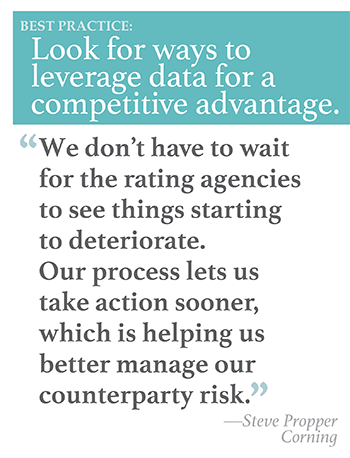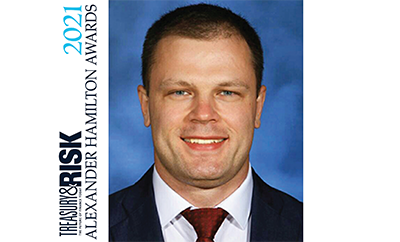
Credit risk management is a big deal at Corning Incorporated.With an accounts receivable portfolio in excess of $1.7 billion anda derivatives portfolio valued at more than $15 billion, thecompany faces significant exposures to both customers andcounterparties. To ensure that it understood those risks, theCorning treasury team was performing thorough credit reviews of allthe company's sizable trading partners. These reviews wereeffective at identifying vulnerabilities, but they weren'tefficient.
|"It was a very manual process, with individual credit analystsspending a lot of time on each company," explains Stephen Fowler,director of liquidity and investment management for Corning. "Aprivate company with a very small market capitalization wouldreceive the same level of attention as a mega-cap company that wasalready being covered by credit analysts from S&P, Moody's, andfixed-income houses around Wall Street. We were looking at the samemetrics they were, we were just doing it in-house."
|Treasury began to re-evaluate the efficiency and effectivenessof its credit risk management. "Our treasury function is driven bythe constant quest to make sure we're efficiently utilizing ourscarce resources," Fowler says. "We looked at whether it made sensefor us to spend time reviewing credits that were already largelybeing covered by other sources. The answer was that internal staffwould be better off focusing on smaller, private companies that areunder-followed by the ratings agencies."
|At the same time, treasury leaders looked at whether credit riskmanagement processes should move into a shared-service center. Thisfollowed a broader trend at the company. Over the past few years,Corning has gradually transitioned a number of routine, repeatabletreasury processes into corporate shared-service centers.
|"Across the board, we're moving in the direction of havingtreasury focus more on the policy and less on the execution,"explains Steve Propper, vice president and corporate treasurer. Asan example, he says, "treasury sets the strategy for our cashmanagement processes and picks our banking partners, but sharedservices handles all the tasks involved in the execution of themovement of cash. A lot of treasury processes have followed thispattern, and it has been working quite well."
|For credit management, the company created a center ofexcellence in its shared-service center in Budapest. "We moved mostof our credit analysts out of treasury," Propper says. "Sharedservices is now responsible for the execution of credit management,while treasury focuses on setting the overall strategy, monitoringthe metrics, and making credit decisions when there's a question."Today, the center of excellence performs a comprehensive creditreview of every counterparty for which financial details are notpublicly available. Treasury reviews that research, then authorizesthe credit limit.
| For customers that are largepublic companies, treasury developed a streamlined process toestimate probability of default. Due to prior work in the capitalmarkets, Propper and Fowler were familiar with the Merton Distanceto Default Model, which looks at the likelihood of default by agiven counterparty as a barrier call option on the organization'stotal assets with a strike price equal to the organization'sliabilities. Under their guidance, the treasury team developed asystem that pulls data from public feeds, such as Bloomberg, thenruns Merton model analytics in Python.
For customers that are largepublic companies, treasury developed a streamlined process toestimate probability of default. Due to prior work in the capitalmarkets, Propper and Fowler were familiar with the Merton Distanceto Default Model, which looks at the likelihood of default by agiven counterparty as a barrier call option on the organization'stotal assets with a strike price equal to the organization'sliabilities. Under their guidance, the treasury team developed asystem that pulls data from public feeds, such as Bloomberg, thenruns Merton model analytics in Python.
"It's very elegant," Fowler says. "We're relying on publicmarket data, so our model updates in real time. And then we'rereverse-engineering the math, looking at the probability that thecompany's liabilities will exceed its equity at any point in thenext year."
|Despite the model's sophistication, the system doesn't run onautopilot. It calculates the maximum acceptable exposure to eachcustomer. Then Corning's treasury team sets a credit limit at alevel below the model's determined maximum. "If a customer'sdesired credit exceeds that initial limit, or if something changeswith their business, we can kick the credit limit out for formalreview," Fowler says. "The idea is that we know our risk tolerance,and if our exposure to a particular company gets close to thatlevel, we evaluate whether we should be concerned or we'recomfortable with the situation."
|For derivatives counterparties, Corning's treasury group wantedto use a modified version of the same process, but one that wouldfactor in the term structure of the company's exposures. Theyimplemented a process that uses a Monte Carlo option model todetermine the 95th percentile forward curve for each currency pairin the company's portfolio, for every quarter-end over the life ofthe contract, and values each derivative at each quarter-end at themodeled forward rate to assess the maximum likely exposure to thebank counterparty.
|The process is quite technical, Fowler admits. "We have to valuethe derivatives over time, even if they're very long-dated, and wehave to look at how each currency pair might change over time. Wedon't just look at our exposure today; we value our maximumforeseeable gain at every quarter-end over the life of thederivative." For each future period, they add up the potentialfuture values of all contracts for the counterparty to arrive at aterm structure of the company's counterparty risk.
|
See also:
- The Opportunity Cost of Risk Avoidance
- On-demand webcast featuring Corning's Stephen Fowler: How Corporate Cash Management Is Evolving
|
The team reaped the benefits of this approach recently, when oneof Corning's financial counterparties experienced businesschallenges. "The model gave us a yellow warning light very earlyon," Propper says. "Initially we just moved to shorter-datedderivatives. Then as the yellow light got brighter and brighter, weput even the short-dated derivatives on pause. Since then,conditions for the financial institution have continued to getworse."
|This ability to recognize emerging exposures very early is a keybenefit of the new process. "We don't have to wait for the ratingagencies to see things starting to deteriorate," Propper says."Once they downgrade a credit, that company's problems are verywell-known, and it might already be experiencing a mass exit. Ournew process lets us take action sooner, which is helping us bettermanage our counterparty risk."
|In addition, because credit analyses for public counterpartiesnow rely heavily on the new system, the credit analysts in thecenter of excellence have significantly more time to dedicate tounderstanding credit risks of the 40 percent of Corning customersthat are either private or have requested credit limits above themodel's determination of maximum acceptable risk. "Corning'sfinance function has a vision of being a world-class organization,"Propper concludes, "and one of the key deliverables of thisframework is the ability to deliver meaningful analysis. The newprocess yields valuable, actionable insights on meaningfulfinancial exposures for the company."
Complete your profile to continue reading and get FREE access to Treasury & Risk, part of your ALM digital membership.
Your access to unlimited Treasury & Risk content isn’t changing.
Once you are an ALM digital member, you’ll receive:
- Critical Treasury & Risk information including in-depth analysis of treasury and finance best practices, case studies with corporate innovators, informative newsletters, educational webcasts and videos, and resources from industry leaders.
- Exclusive discounts on ALM and Treasury & Risk events.
- Access to other award-winning ALM websites including PropertyCasualty360.com and Law.com.
*May exclude premium content
Already have an account? Sign In
© 2024 ALM Global, LLC, All Rights Reserved. Request academic re-use from www.copyright.com. All other uses, submit a request to [email protected]. For more information visit Asset & Logo Licensing.







